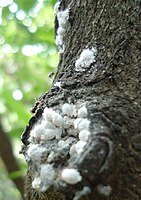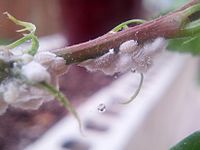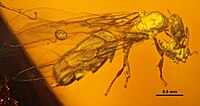
Whiteflies are Hemipterans that typically feed on the undersides of plant leaves. They comprise the family Aleyrodidae, the only family in the superfamily Aleyrodoidea. More than 1550 species have been described.

Scale insects are small insects of the order Hemiptera, suborder Sternorrhyncha. Of dramatically variable appearance and extreme sexual dimorphism, they comprise the infraorder Coccomorpha which is considered a more convenient grouping than the superfamily Coccoidea due to taxonomic uncertainties. Adult females typically have soft bodies and no limbs, and are concealed underneath domed scales, extruding quantities of wax for protection. Some species are hermaphroditic, with a combined ovotestis instead of separate ovaries and testes. Males, in the species where they occur, have legs and sometimes wings, and resemble small flies. Scale insects are herbivores, piercing plant tissues with their mouthparts and remaining in one place, feeding on sap. The excess fluid they imbibe is secreted as honeydew on which sooty mold tends to grow. The insects often have a mutualistic relationship with ants, which feed on the honeydew and protect them from predators. There are about 8,000 described species.
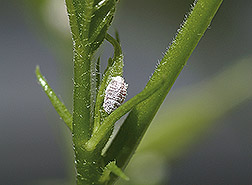
Maconellicoccus hirsutus, is a pest of many plants, trees, and shrubs. It infests hibiscus, citrus, coffee, sugar cane, annonas, plums, guava, mango, okra, sorrel, teak, mora, pigeon pea, peanut, grapevine, maize, asparagus, chrysanthemum, beans, cotton, soybean, cocoa, and many other plants. The pest forms colonies on the host plant, and if left undisturbed, the colonies will grow into large masses of white waxy coverings on branches, fruiting structures, leaves, and even whole plants, including large trees.

Trophobiosis is a symbiotic association between organisms where food is obtained or provided. The provider of food in the association is referred to as a trophobiont. The name is derived from the Ancient Greek τροφή (trophē), meaning "nourishment", and -βίωσις (-biosis), which is short for the English word symbiosis.

Acropyga is a genus of small formicine ants. Some species can be indirect pests. A. acutiventris, which is found from India to Australia, tends subterranean, root-feeding mealybugs of the species Xenococcus annandalei. Living, gravid females are carried in the jaws of A. acutiventris queens during their nuptial flight, to establish the symbiotic association in founding colonies. Other Acropyga species have relationships with different species of mealybugs, and it could be a trait common to the whole genus.

Pseudococcus viburni is a close relative of the grape mealybug and a pest of the vineyards around the world.

Electromyrmococcus is an extinct genus of mealybug in the Pseudococcidae subfamily Rhizoecinae. The genus currently contains three species, all from the early Miocene, Burdigalian stage, Dominican amber deposits on the island of Hispaniola.
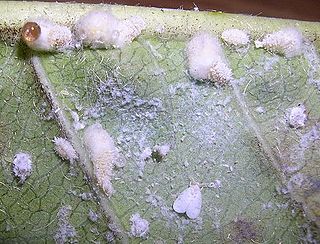
Paracoccus marginatus, commonly known as the papaya mealybug, is a small sap-sucking insect in the mealybug family, Pseudococcidae. It is found on a number of different hosts, including economically important tropical fruit trees and various ornamental plants.
Xenococcus annandalei is a species of mealybug in the family Pseudococcidae that infests the roots of certain species of trees.
Phenacoccus manihoti is a mealybug insect species.

Planococcus citri, commonly known as the citrus mealybug, is a species of mealybugs native to Asia. It has been introduced to the rest of the world, including Europe, the Americas, and Oceania, as an agricultural pest. It is associated with citrus, but it attacks a wide range of crop plants, ornamental plants, and wild flora.

Acropyga epedana is an ant in the subfamily Formicinae. It lives permanently underground in the Chiricahua Mountains in Arizona and forms a mutualistic association with the mealybug Rhizoecus colombiensis.
Balanococcus cordylinidis, the cabbage tree mealybug, is a species of insect in the family Pseudococcidae.
Rhynocoris longifrons is a species of assassin bug in the family Reduviidae. It is a predator of other insects and is found in Asia. Crops on which it is found feeding on pests include pigeon pea, cardamom and peanuts. The insects are potentially useful in biological control because they are more resistant to pesticides than are the pests they consume.

Phenacoccus solenopsis, the cotton mealybug or solenopsis mealybug, is a species of mealybug in the family Pseudococcidae. Having originated in North America, it has spread to other parts of the world and become a major pest of cotton crops.
Geococcus coffeae is a species in the mealybug family, Pseudococcidae, commonly known as the coffee root mealybug, or brown scale. It lives underground where it inserts its mouthparts into roots and sucks the sap.

Pseudococcus comstocki, common name Comstock mealybug, is a species of mealybug. The species was first discovered in 1902 in Japan. It is an invasive pest species that feeds on fruit and plants.

Scymnus (Scymnus) nubilus, is a species of lady beetle found in Pakistan, India, Bangladesh, Sri Lanka, Nepal, Myanmar, China, and Asia Minor.

Scymnus (Pullus) coccivora, is a species of lady beetle found in India, Bangladesh, Sri Lanka, Malaysia, and Pakistan and probably in Thailand, Bermuda, British Virgin Islands, Grenada, Saint Kitts and Nevis, Trinidad and Tobago and Papua New Guinea.

Planococcus ficus, commonly known as the vine mealybug, is a species of mealybug, belonging to the family Pseudococcidae, native to tropical and subtropical regions. The vine mealybug is found in Europe, Northern Africa, Southern Africa, the Americas, and the Middle East. The vine mealybug is invasive to weedy plants in many different regions of the world.


